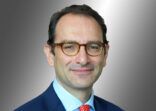The firm has Hong Kong-domiciled funds, which will qualify for southbound investment, he said.
“We also have a joint venture in China with China Construction Bank. They have a number of mutual funds there. We are in active discussion with them about which of their funds may qualify and [which] we may be open to distribute through the northbound flow,” said West.
To participate in the MRF, funds must be domiciled in Hong Kong or China and must have at least a one-year track record with minimum assets worth RMB200m ($32m).
West said after the MRF launches July 1, capital is initially expected to flow into the Hong Kong market due to valuations that are more attractive than mainland shares.
“You will see continued flow into the Hong Kong equity market.”
Funds investing in Hong Kong and China shares will be of greater interest to investors initially, he said.
“Further down the road, as mainland investors become comfortable with international investments, they will certainly start to look for opportunities to invest in other international markets such as regional equities or even US and global equities.”
The firm also has products in the pipeline, but is waiting for a quota under the Renminbi Qualified Foreign Institutional Investor programme. It intends to launch China A-share and onshore fixed income products.
In January, West detailed the firm’s Asia expansion plans to Fund Selector Asia, which included strengthening the third-party distribution network and launching China onshore products.
“We are, like many investors in Hong Kong, waiting for the next batch of quota to be allocated. We are reasonably confident that this should be coming relatively soon.”
In terms of expanding the distribution headcount, the firm is currently looking for people in the Middle East and Asia, West said.
Rotation from bonds
Results of a recent survey by Principal showed that global investors are favouring equities and there is a significant shift from fixed income into equities.
“The rotation started a few years ago. But now more and more people are starting to reallocate from bonds into equities.”
The report mentions the ‘bondification’ of equities, which means that people are looking for equities that have an income-type feature, West explained.
Despite this rotation, investors will still have fixed income assets as a part of diversified portfolio, he said.
“People are gravitating from long-only bond investments to areas such as credit and high yield. The other area is in go-anywhere credit products. These are active fixed income products, which invest across the capital structure and use sovereign, investment grade and high yield bonds.”
Global real estate investment trusts and multi-asset funds, which invest across asset classes and offer targeted returns, are also sought, he said.
Alternatives rising too
High net worth investors in Asia have a bigger risk appetite and prefer a mix of traditional and alternative investing, according to the survey.
A majority (72%) said they would invest in actively-managed equity and bond products for generating return in the medium-term. However, alternative asset classes such as private equity (65%) and real estate (62%), followed closely.
“Investors in Asia have been the first or second generation in terms of creating wealth and are far more comfortable taking risk. They are far more sophisticated investors and are looking for investments that do not just preserve wealth or serve as inflation protection products, but offer capital growth,” West said.
By comparison, in developed markets the investment objective of HNWIs is correlated with wealth preservation, he added.
















